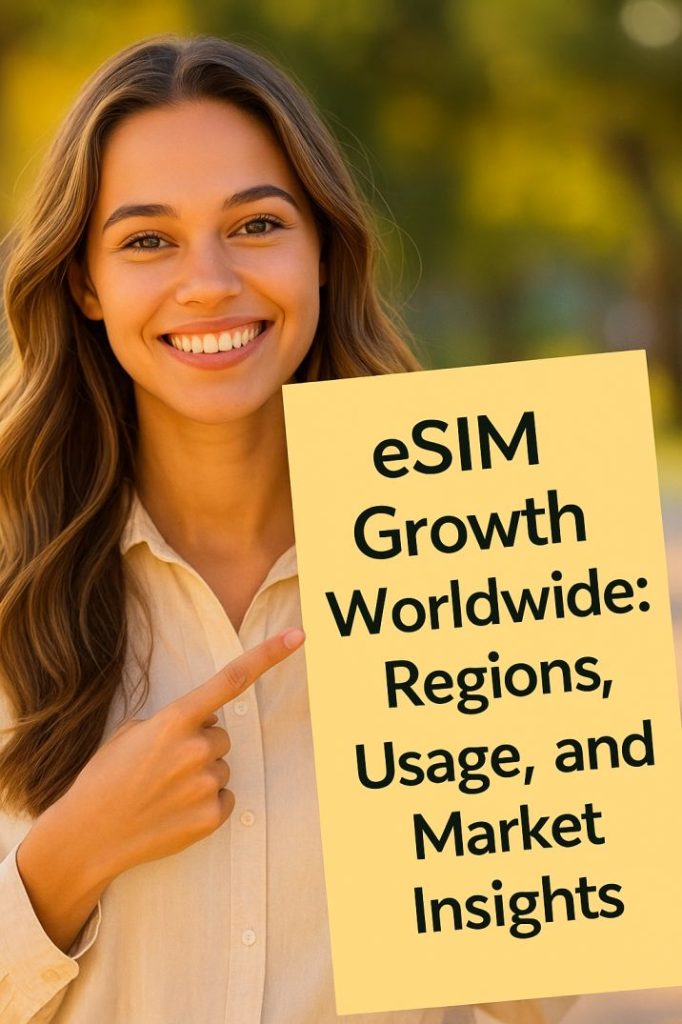
Introduction: eSIM Growth Worldwide
Ever wondered how eSIM Growth Worldwide is transforming global connectivity? This innovative chip is reshaping how we use phones, watches, and other devices. From Asia to Europe and the Americas, eSIM adoption is accelerating at an impressive pace. This article explores the regions embracing eSIMs, the rising number of users, and key market developments driving this technological shift.
Understanding eSIMs
An eSIM, or embedded Subscriber Identity Module, is a permanent chip inside your device that lets you switch networks without a physical card. It’s a game-changer for convenience and device design.
- Eliminates the need for removable SIMs.
- Works seamlessly with today’s tech gadgets.
- Expanding rapidly across the globe.
Regions Leading eSIM Adoption

eSIM technology is taking root in diverse parts of the world, with strong momentum in several areas.
Top Global Regions
- Places like the United States, Canada, United Kingdom, Japan, and Germany are seeing widespread eSIM use.
- Local networks in these regions are fully on board.
Asia’s Key Players
- China, South Korea, and Thailand are driving eSIM growth in Asia.
- Other nations in the region are starting to follow suit.
Americas’ Expanding Reach
- Brazil, Mexico, and Argentina are embracing eSIMs through local providers.
- Latin America is gradually catching up.
Notable Network Operators
- Big names such as Vodafone, AT&T, T-Mobile, and au (Japan) support eSIMs.
- Smaller regional networks are also joining the trend.
Discovering eSIM Services
- Check sites like Nomadoverse, Yesim, Airalo or esim-world.com for a list of supported areas and carriers.
- These are handy for travelers needing quick setups.
Varying Regional Support
- Some locations offer limited eSIM options.
- Verify with your provider for the most current info.
Rising eSIM User Numbers

More people are adopting eSIMs, reflecting its growing appeal.
- 2023: Over 1 billion devices featured eSIM or dual-SIM capabilities.
- 2024: Approximately 40 million travelers used eSIMs (industry data).
- 2025: Anticipated to rise to 3.4 billion (from Global Connection Stats, included here for context).
- 2028: Expected to climb past 215 million users.
- 2030: Potentially 77% of smartphone links could use eSIMs, with North America nearing 98%.
Market Trends and Projections
The eSIM sector is thriving, boosted by new devices and advanced networks.
Market Value Overview
- 2023: The consumer eSIM industry was valued at around USD 1.22 billion.
- 2030: Projected to reach USD 6.29 billion, with a 20% yearly growth rate.
- 2024: Total market hit USD 13.54 billion, aiming for USD 31.82 billion by 2030.
Leading Market Segments
- Automotive Connectivity: Claimed 24.2% of the market in 2023.
- Wearable Devices: Forecasted to increase by 27.9% annually until 2028.
- Service Offerings: Accounted for 88.6% of the market (USD 4.2 billion) in 2023.
Global Connection Stats
- 2021: Recorded 1.2 billion eSIM connections.
- 2023: Smartphone eSIM connections grew to 310 million.
- 2024: Smartphone eSIM connections grew to 598 million from 310 million in 2023.
- 2025: Anticipated to rise to 3.4 billion.
Regional Market Highlights
eSIM adoption varies by region, with each showing distinct progress.
North America’s Dominance
- Controls 35-40% of the global market in 2024.
- United States contributes 82% to the region’s revenue.
- Growth pace: 8.7% per year through 2032.
Europe’s Strong Presence
- Generated USD 2.57 billion in 2023.
- Expected to grow at 8.3% annually until 2030.
- France and Italy are emerging as growth leaders.
Asia-Pacific’s Rapid Rise
- Leads as the fastest-growing area, with China, India, and Japan at the helm.
- China may achieve 1.5 billion eSIM connections by 2030.
- Usage could surge from 2% in 2023 to 78% in 2030.
Developing Markets
- Latin America, Middle East, and Africa each hold 5% of the market share.
- Africa introduced the most new eSIM-supporting nations in 2023.
- Argentina is poised for significant future growth.
eSIMs in the Travel Industry

Travelers are turning to eSIMs for affordable data solutions.
- 2023-2028: Investment in travel eSIMs may soar by 500%, reaching $10 billion.
- Average expense: $16 per trip, compared to $41 for roaming.
- India, Brazil, and Singapore are leading the charge.
Device and Manufacturer Support
More devices are now eSIM-ready, fueling adoption.
- First eSIM Device: Google Pixel 2 debuted in 2017.
- eSIM-Only Models: Motorola RAZR (2019), Apple iPhone 14 (2022).
- 2025: Up to 60% of smartphone sales may include eSIMs.
- Leading brands: Samsung with 40 models, Apple with 29, Motorola with 28.
Environmental Advantages
eSIMs offer a greener alternative to traditional SIMs.
- Traditional SIMs: Generate 229 grams CO2e over 3 years.
- eSIMs: Produce 123 grams CO2e, cutting emissions by 46%.
- 2024: SIM manufacturing contributes over 140,000 tons of CO2e annually.
Conclusion
eSIM Growth Worldwide is reshaping connectivity across 123 countries. Usage is projected to surge from 40 million in 2024 to an estimated 215 million by 2028, with the market aiming for USD 31.82 billion by 2030. eSIMs offer travel convenience and environmental benefits, marking a new era in global tech adoption.
